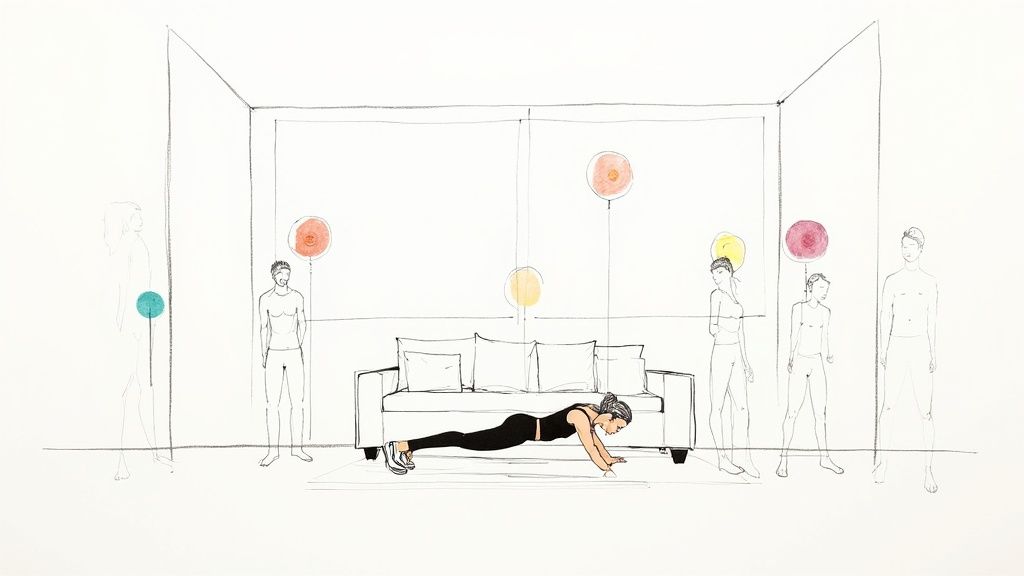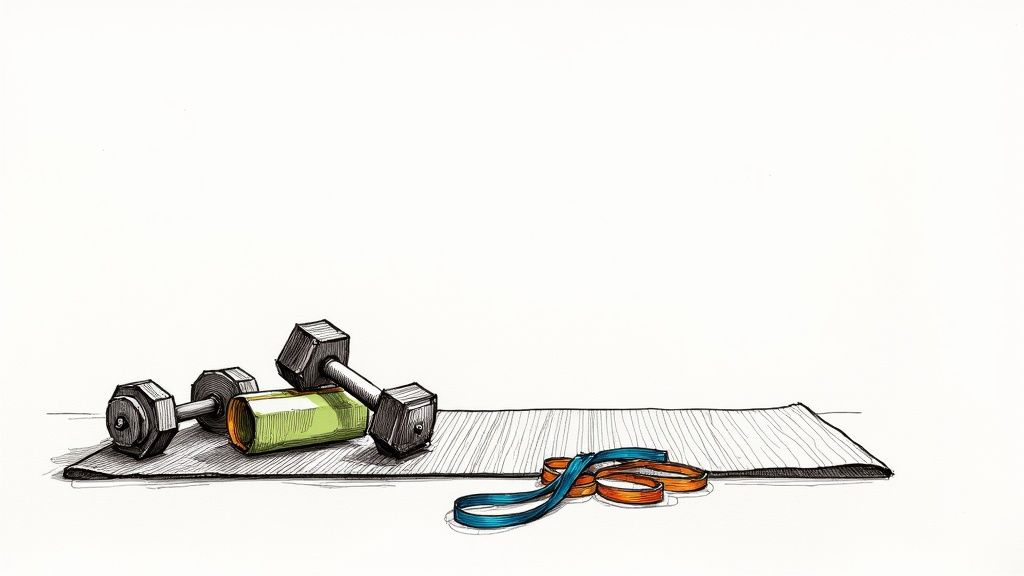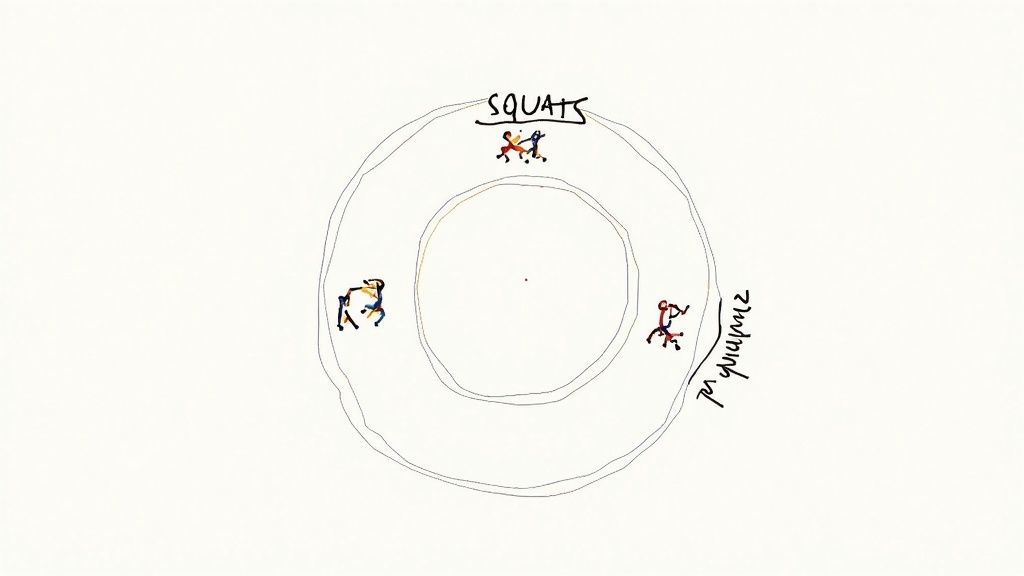
In short 👇🏽
Circuit Training at Home for Real Results
This article is proposed by Gymkee, the personal trainer software that allows you to deliver the best coaching experience to your clients while saving time and growing your personal training business.
Try Gymkee for free for 14 daysCircuit training at home is an effective way to improve strength and cardiovascular fitness by moving through a series of exercises with minimal rest. It’s a time-efficient method for getting a full-body workout.
If you have a packed schedule, this is a practical solution. It's one of the most efficient ways to train without spending a large portion of your day on exercise.
Why Circuit Training at Home Actually Works

Let's get straight to the point. Circuit training at home is more than just convenient; it's an efficient strategy for achieving tangible fitness results. Its effectiveness lies in blending intensity with efficiency, making it suitable for fitting fitness into a busy schedule.
The goal is to keep your heart rate elevated, combining cardiovascular benefits with resistance training in the same session. This combination is effective for burning calories and improving overall fitness in a short amount of time. The physiological principles are similar to those underlying the energy requirements for high-intensity fitness like CrossFit.
Fusing Modern Tech with a Timeless Technique
Technology has significantly impacted home workouts. Fitness trackers and apps provide real-time data that was once only available to professional athletes.
This isn't a temporary fad. According to the American College of Sports Medicine, wearable technology has been a top fitness trend for several years. Devices like heart rate monitors and smartwatches offer instant feedback on physiological responses. The global market for this technology is projected to grow by 17.4% annually from 2024 to 2033, according to a report by Towards AI.
For your home circuits, this tech offers a few key advantages:
- Objective Progress Tracking: Stop guessing. See exactly how your heart rate responds during a workout, estimate calorie expenditure, and track performance improvements over time.
- Personalized Intensity Levels: Use heart rate zones to ensure you're working hard enough to elicit adaptation, but not so hard that you risk overtraining or injury.
- Sustained Motivation: Hitting daily goals and seeing the data provides a motivational boost that encourages consistency.
By using this data, you can refine your circuit training at home, ensuring each session is optimized for your specific goals. It's about building a sustainable habit that delivers measurable results.
Building Your First Bodyweight Circuit
Ready to build your first bodyweight circuit? You don’t need complex formulas—just a simple framework. The goal is to create a routine that works the entire body, elevates your heart rate, and flows smoothly from one exercise to the next.
This approach provides a balanced, full-body workout. By mixing upper-body, lower-body, and core movements, you can prevent muscle imbalances and increase caloric expenditure in less time.
Designing Your Circuit Layout
Before you begin, map out your workout. A little planning helps create an effective session.
This simple flow shows you how to organize your space.

Arranging your "stations" logically reduces transition time, which is key to maintaining intensity and workout efficiency.
Selecting Your Exercises
The core of any good circuit training at home plan is the exercise selection. You’ll want to pick 5-6 bodyweight movements that cover major muscle groups. A solid rule of thumb is to select one exercise from each of these categories.
- Lower Body: Squats, lunges, or glute bridges.
- Upper Body Push: Push-ups are a staple for the chest, shoulders, and triceps. Perform them on your knees or toes.
- Upper Body Pull: No pull-up bar? Inverted rows using a sturdy table or doorway rows are effective substitutes.
- Core: Planks, leg raises, or crunches will engage your midsection.
- Full Body/Cardio: Burpees, jumping jacks, or high knees are perfect for elevating your heart rate.
Choosing one from each category ensures a balanced routine, so you're not overworking one muscle group while neglecting another. If you need a more guided approach, a workout builder can help you design effective routines with clear instructions.
Remember, the best workout is the one you can perform consistently with good form. Pick exercises that are challenging but don't force you to sacrifice technique. You can increase the difficulty later.
Nailing Your Work-to-Rest Ratio
Your work-to-rest ratio controls the workout's intensity. The objective is to find a sustainable pace that challenges both your muscular and cardiovascular systems.
For beginners, a 1:2 work-to-rest ratio is a good starting point. For instance, perform 30 seconds of work followed by 60 seconds of rest before the next exercise. This provides ample recovery time between stations.
As your fitness improves, you can adjust the ratio to increase the difficulty.
- Intermediate Level: Move to a 1:1 ratio (e.g., 45 seconds of work, 45 seconds of rest).
- Advanced Level: Increase intensity with a 2:1 ratio (e.g., 40 seconds of work, 20 seconds of rest).
Once you've completed all exercises in your circuit, you have finished one round. Take a longer break of about 2-3 minutes, then repeat. Aim for 3-5 rounds, depending on your available time and energy.
Here is a simple template to structure your first workout.
Beginner Bodyweight Circuit Template
After your rest period, you would start "Round 2" and repeat the sequence. This structure is flexible; feel free to swap exercises or adjust times as you progress.
Your Go-To Equipment-Free Exercises

You don’t need a room full of equipment to get an effective workout. Your own body is a powerful tool for resistance training.
By mastering a few fundamental bodyweight movements, you have everything you need to build a challenging circuit training at home routine. These exercises work multiple muscle groups simultaneously, making your sessions more efficient.
Let's break down some of the most effective equipment-free moves, focusing on proper form and how to modify the difficulty.
Lower Body Powerhouses: Squats and Lunges
Squats are a foundational lower-body exercise, targeting the quads, hamstrings, and glutes while engaging the core for stability.
Here's how to do a proper squat:
- Stand with your feet shoulder-width apart, toes pointing slightly outward.
- Keep your chest up and back straight as you send your hips back and down, as if sitting in a chair.
- Lower yourself until your thighs are parallel to the floor, or as low as you can comfortably go while maintaining good form.
- Drive through your heels to return to the starting position.
Lunges are essential for building single-leg strength and balance. Stand tall, step one foot forward, and lower your hips until both knees are bent at approximately a 90-degree angle. Push off your front foot to return to the start, then switch sides.
A common mistake with both squats and lunges is letting the knees collapse inward (knee valgus). Focus on keeping your knees aligned over your toes to protect your joints and ensure the correct muscles are engaged.
Upper Body and Core Essentials
For upper-body pushing strength, the push-up is highly effective. It works the chest, shoulders, and triceps. If a standard push-up is too difficult, start with your knees on the floor. The key is maintaining a straight line from your head to your knees (or heels).
The plank is a primary core stabilization exercise. Assume a push-up position, on your hands or forearms, and hold. Keep your back flat and core engaged. Avoid letting your hips sag or rise. Holding a solid plank for 30-60 seconds can significantly improve core endurance.
The All-In-One Finisher: Burpees
The burpee is a full-body conditioning exercise that combines a squat, a push-up, and a jump into one sequence. It is an efficient way to elevate your heart rate and build explosive power.
How to perform a burpee:
- Start standing, then drop into a squat and place your hands on the floor.
- Kick your feet back into a plank position.
- Perform a push-up.
- Jump your feet back toward your hands.
- Explode up into a jump. That's one repetition.
Making It Your Own: Modifications for All Levels
Every exercise can be scaled. Your goal is to find a version that is challenging but allows you to maintain proper form.
By mastering these movements and their variations, you can create a wide variety of home workouts. To explore other movements, you can consult a comprehensive library of fitness exercises to perfect your form.
How to Progress and Avoid Plateaus

Once your circuit starts to feel manageable, it's a sign that your fitness is improving. It's also an indication that a training plateau may be approaching.
To continue seeing results from your circuit training at home, you must continuously challenge your body. This is the principle of progressive overload, which means gradually increasing the demands placed on your body over time. Without it, your body adapts and stops making further progress.
You don’t need heavy weights to apply this principle. You can make bodyweight circuits progressively harder by adjusting key variables. This forces your muscles to keep adapting, which is how you achieve long-term gains.
Smart Ways to Increase the Challenge
Progressive overload should be strategic. Instead of just adding reps randomly, focus on making small, specific, and measurable changes to your circuit.
A practical method is to increase your workout density—doing more work in the same amount of time.
- Shorten Your Rest Periods: If you’re resting for 60 seconds between exercises, try reducing it to 45 seconds. This forces your cardiorespiratory system and muscles to recover faster.
- Add Another Round: Once you can complete your planned number of rounds with good form, add one more. This is a simple way to increase total workout volume.
- Increase Reps or Work Time: Try adding two more reps to each exercise. Or, if using timed intervals, extend your work time from 30 seconds to 35. These small increments accumulate over a full circuit.
Remember, progress is not always linear. The goal is a gradual upward trend over weeks and months, not a significant jump in every workout.
Introducing New Tools and Better Fuel
When you are ready, incorporating affordable equipment can introduce new challenges. A set of resistance bands or a kettlebell can add resistance to movements like squats, glute bridges, and rows, increasing the muscular demand.
As your workouts become more demanding, nutrition becomes more critical. Proper nutrition provides the energy to perform and the nutrients needed for recovery and muscle repair. To align your diet with your fitness goals, you can use tools like a nutrition builder to help you plan your meals effectively.
Watch Out for These Common Home Circuit Mistakes
Even a well-designed plan for circuit training at home can be undermined by common mistakes. These can stall your progress, increase injury risk, and reduce the effectiveness of your workout.
The most frequent mistake is sacrificing good form to increase speed. The purpose of a circuit is to maintain intensity, but never at the expense of proper technique. Rushing through reps with sloppy form reduces the effectiveness of the exercise and places unnecessary strain on your joints. Quality of movement should always take precedence over quantity.
Skipping Your Warm-Up and Cool-Down
Starting a high-intensity circuit without a warm-up is not advisable. A proper warm-up is non-negotiable. It gradually increases your heart rate, increases blood flow to your muscles, and prepares your nervous system for the work ahead.
Just five minutes of dynamic movement, such as bodyweight squats, arm circles, and leg swings, can make a significant difference. This habit reduces injury risk and can improve your performance during the workout.
Similarly, a cool-down is important. Stopping abruptly can leave your heart rate elevated and may cause dizziness. A few minutes of light stretching helps your body return to its resting state and can aid in muscle recovery.
Neglecting your warm-up is one of the quickest ways to get injured. Treat it as an essential part of the workout, not an optional add-on.
Creating an Unbalanced Workout
It's common to favor exercises you enjoy or are good at, but this can lead to an unbalanced routine. Many people focus on "push" movements like push-ups and squats while neglecting "pull" movements and dedicated core work.
Over time, this can create muscle imbalances that may negatively affect posture and lead to chronic pain.
A well-rounded circuit should address all fundamental human movement patterns:
- Push: Push-ups, overhead presses.
- Pull: Rows, pull-ups.
- Squat: All squat variations.
- Hinge: Glute bridges, deadlifts.
- Core: Planks, leg raises, anti-rotation exercises.
This balanced approach is a core component of hybrid training, which blends different fitness styles for functional strength. Hybrid athlete training is one of the latest fitness trends taking over home gyms. By designing balanced circuits, you build a body that is not only fit but also resilient.
Your Questions on Home Circuits Answered
When starting a new fitness routine, questions are normal. Getting the practical details right for circuit training at home is key to building a sustainable habit.
Here are answers to some of the most common questions.
How Often Should I Do Circuit Training?
For noticeable changes in strength and stamina, aim for 3 to 4 sessions per week on non-consecutive days. This rest day allows your body to recover and rebuild muscle, which is when adaptations occur.
If you're just starting, 2-3 sessions a week is a suitable target. Consistency is more important than intensity when building a new routine. Listen to your body and add more sessions when you feel ready.
The goal is not constant soreness. Consistent effort paired with adequate rest is the formula for long-term progress.
Can I Build Muscle with Only Bodyweight Circuits?
Yes. Bodyweight circuits are effective for building functional strength and lean muscle mass. While you may not build the same muscle bulk as a powerlifter, you can develop a strong and athletic physique.
The key is applying the principle of progressive overload. You must continually find ways to challenge your muscles.
You can do this by:
- Adding more repetitions to each set.
- Reducing your rest time between exercises.
- Progressing to more difficult exercise variations (e.g., from a regular squat to a jump squat).
This gradual increase in demand forces your muscles to adapt and grow.
How Long Should a Home Circuit Session Be?
Circuit training is highly time-efficient. An effective session can last anywhere from 20 to 45 minutes. A well-structured 25-minute workout can be more beneficial than an hour of unfocused training.
Be sure to include a 5-minute dynamic warm-up before you start and a 5-minute cool-down with stretching afterward. The effectiveness of the workout is determined by the quality of your effort, not just the duration.
Ready to take the guesswork out of your workout planning and deliver professional results for your clients? With Gymkee, you can design, manage, and sell your fitness and nutrition programs all in one place. Save hours every week and give your clients a premium experience with our intuitive platform. Start your free 14-day trial today and see how Gymkee can transform your coaching business.
.svg)